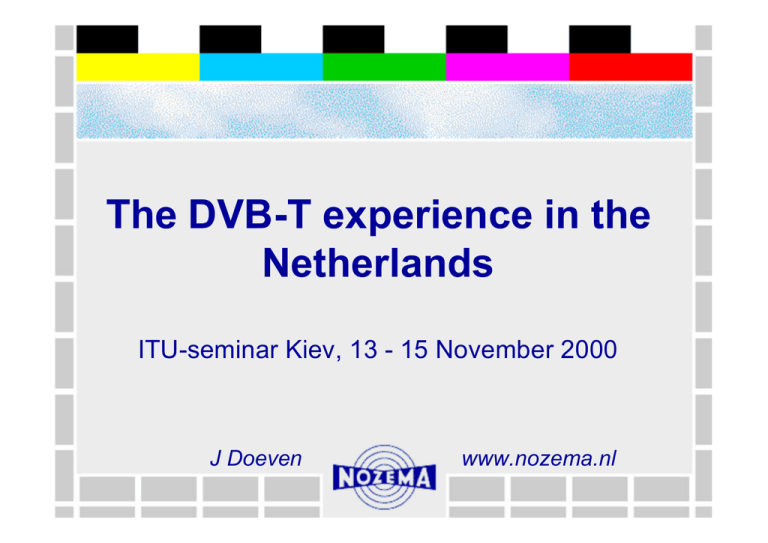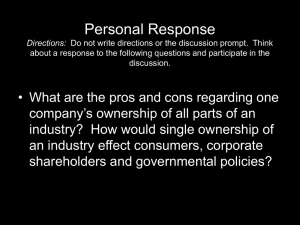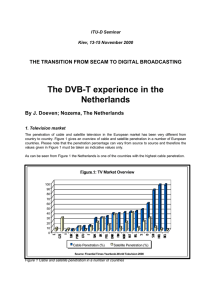The DVB-T experience in the Netherlands J Doeven
advertisement

The DVB-T experience in the Netherlands ITU-seminar Kiev, 13 - 15 November 2000 J Doeven www.nozema.nl Content The DVB-T experience in the Netherlands • • • • • Television market Digital television offer Roll out Network EMC Television market (1) TV Market Overview 100 90 80 70 60 50 40 Cable Penetration (%) BEL HOL SUI D S IRL AUT NOR FIN DNK POL UK SVK F LTU POR TUR I CZE 0 E 30 20 10 Satellite Penetration (%) Source: Finantial Times Yearbook-World Television 2000 Television market (2) Consequences of high cable penetration • Almost no roof-top antennas • High number of services (up to 30) • Common to pay monthly subscription for delivery of services DVB-T : ã indoor reception by means of simple antenna ã at least 20 programmes Television market (3) Market research Penetration: 10 - 20% households after 10 years Provided: êindoor reception êat least 20 services êcompetitive price Parameters influencing market penetration: ã subscription fee ã renting and subsidising STB’s ã promotion ã new services ã availability of integrated digital television sets The Digitenne offer (1) •Monthly subscription •Rental STB •Competitive price •Indoor reception •5 multiplexes •Return path via PSTN •Multiplex operator •Consortium consisting of main market players •20 most popular tv services •15 radio channels •3 pay-tv channels •Enhanced teletext •EPG, weather and traffic info •Additional innovative services in a second phase (shopping and info channels, games, internet tv) ... The Digitenne offer (2) Reception uRooftop antenna Car Tram Boat uSimple antenna Ýportable Ýmobile Indoor stationary Portable receiver The roll-out (1) Introduction has been delayed • Government policy – considerable political debate on licensing mechanism: auction or “beauty contest” • International frequency co-ordination – negotiations with neighbouring countries started in 1996 • Technical developments – sometimes better to wait for new developments • Licenses for construction and modifications of masts The roll-out (2) Indoor coverage Greater Amsterdam 20% population May 2001 5 multiplexes Randstad 50% population Q4 2001 5 multiplexes Whole country After analogue switch off (2003 - 2010) 6 multiplexes The network (1) Requirements Commercial: ã Indoor reception ã Package of 20 programmes Technical: • Transmitter sites in or near urban areas to achieve good indoor reception • As far as possible use of existing sites (television, FM, or telecom) • More or less equal coverage of the five(later six) multiplexes • A regional structure of the multiplex for the public services The network (2) • >60 sites – now 10 sites with ERP > 1kW • Small and medium size SFNs • ERP 1 to 10 kW • 64QAM 2/3 • Net bit rate 19.9 Mbit/s • Statistical multiplexing Net- SFNs Tx/ work SFN 1 2 3; 11 Total tx 14 2 3 5; 3; 6 14 3 2 1; 13 14 4 2 1: 13 14 5 2 1; 13 14 SFNs in Randstad area 2n d Ra stag nd sta e d Investment tx network ? 40 mio 3rd Wh stag ole e NL Investment tx network ? 115 mio The network (3) Item Annual costs Transmitter € 12 mio network Running € 7 mio costs Total € 19 mio Costs Annual costs tx network ? 41 mio DVB-T⇔ Cable DVB-T Price/ household ~ € 18 DVB-T 10% ~ € 180 Cable ~ € 900 Investments in digital to be added The network (4) Some results • Field strength highest near a window (even if window is not facing the transmitter) • Moving people having minor impact on reception • “Blocks” in picture (due to noise or interference) more harmful than reduction of bitrate • Good indoor reception in all buildings difficult to achieve Tests EMC (1) The facts • In cable up to 862 MHz • Possibility of interference between off-air and cable channels • Cable system itself ok • Domestic installations often poor quality • Connectors weakest part • Solution in the past: don’t use transmitted frequencies in cable! The problem now • With DVB-T more frequencies off-air • Cable systems used to maximum capacity • Cable companies not willing to adapt channels • No legal means for government to enforce channel usage in cable • Result: major problem EMC (2) Investigations • 20 to 30% of cable households may have interference on one or more channels • if poor connectors are replaced by good ones only 0,02% may have interference Good quality cable and connectors 120 ERP: 10kW heff 100 m 110 100 Receiving height 30 m 90 100 Field strength↑ 0 Distance (m)Õ (dBuV/m) 500 1000 “normal” (poor) quality cable and connectors Conclusion The DVB-T experience in the Netherlands: • • • • • Indoor reception is a must Costs much less than cable More delay than originally expected Dense network structure and use of SFN Difficult to implement nation-wide as long as analogue television is in operation • Connectors of good quality in domestic cable installations are essential THE END Thank you for your attention






